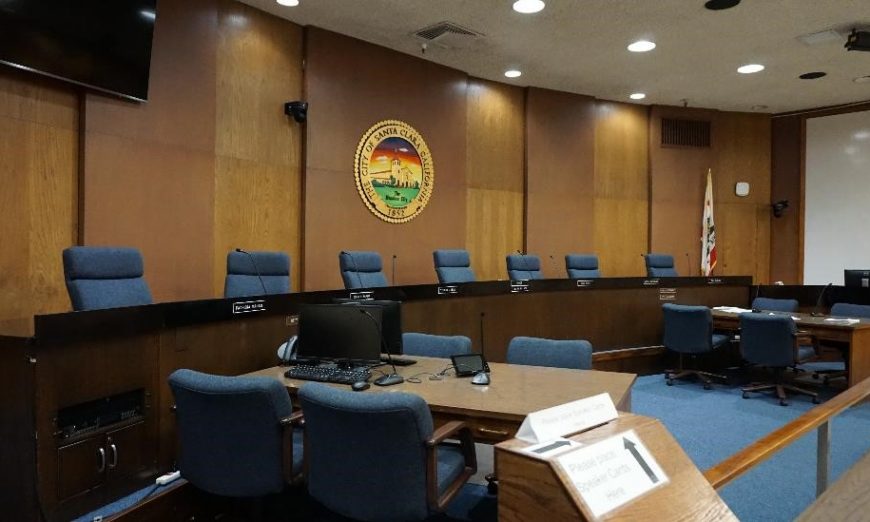Political Scientists Look At Santa Clara’s Landmark 2020 City Council Election

Santa Clara’s two-year journey to a City Council that mirrors the City’s multi-ethnic population is historic and follows Santa Clara’s change to single-member City Council districts, after the City lost a California Voting Rights Act (CVRA).
It’s a safe bet that the historic change will be part of future studies of the impact of the 2002 law. California has no shortage of political scientists looking at how the CVRA has impacted local government in the State, so we asked three of them to weigh in.
Santa Clara’s experience in its first by-district election is typical, although the number of minority representatives in Santa Clara isn’t, according to Loren Collingwood, UC Riverside Associate Professor of Political Science.
Collingwood is the co-author of the first statistical study specifically of CVRA impacts, “Can States Promote Minority Representation? Assessing The Effects Of The California Voting Rights Act.”
“We studied 30 cases,” said Collingwood. “We’re seeing an average of one seat. In larger cities there might be one and a half seats.”
Santa Clara’s minority representation after this election “is larger than our research has found,” Collingwood continued, “but not outside the bounds of rationality. Asian Americans are the fastest growing immigrant population. I would expect that kind of change given the demographic changes in California.”
Santa Clara Turned the Direction of Political Inertia
Santa Clara’s 2020 election was an “interesting” one, said James Lai, Santa Clara University professor of political science and ethnic studies, author of Asian American Political Action: Suburban Transformations, Fellow Asian and Pacific American Vote, which includes studies of nearby cities including Daly City and Cupertino.
In the past, Lai has described Santa Clara as “the great outlier” because demographic changes that have changed the ethnic makeup of Bay Area city governments seemingly left Santa Clara untouched.
Changing demographics have within themselves a “political inertia,” said Lai. “You can stop it by gaming the system, which is what has been happening in Santa Clara. Now you’re starting to see the political inertia turn.”
Minority Councilmembers “create a pipeline — for example, Sunnyvale, Cupertino, Mountain View — they can appoint people that look like them to committees and commissions that have visibility. This allows minorities enter into politics at a critical mass.”
One example is neighboring Cupertino. In 1980 Asian-Americans were 5 percent of that city’s population. In 2020, that number is 65 percent and Cupertino has a majority-minority city council.
At the same time newly elected Councilmembers need to remember, “All politics is still local,” Lai said. “You [minority councilmembers] reflect the entire city. It’s more than special interests and reformers — although that’s how the media will see it.
“You’ve got to win Asian American voters but you can’t rely on that alone,” continued Lai. “Mike Honda and Ro Khanna get a majority of support from non-Asians. You’ve got to create pan-ethnic and multi-racial coalitions. Asian-American live in the same communities and want the same things.”
Cities that are changing demographically are “going through growing pains,” said Lai. “That’s where local government can play a role by easing those tensions. Those are natural feelings and that’s where city government can help the discussions take place.”
Lai offers Cupertino’s City-sponsored Community Roundtable, where 10 members of the community sit down in a public discussion about community concerns and ideas.
Grass Roots Governing
Anaheim City Councilmember José Moreno, Associate Professor and Chair of the Department of Chicano & Latino Studies at California State University, Long Beach not only teaches political science, he’s been living it every day since 2014, when he filed a CVRA lawsuit against the City of Anaheim.
After the City settled and adopted by-district Council elections, in 2016 Moreno won a Council seat in an election that swept a reform Council into power. He served as Anaheim Mayor Pro-Tem in 2018.
Moreno sees parallels between Anaheim’s first by-district election and Santa Clara’s.
“In our first district election we saw a shift right away,” said Moreno. “There was a lot of excitement, a lot more energy because people felt we had a chance.”
District elections make it easier to reach low frequency and new voters, he noted. “A lot more young people came out than previously.”
For first-time and minority voters, campaigning must be high touch, Moreno continued. “In a district system the candidates or their volunteers who know the candidate can provide that personal touch.”
Grassroots effort doesn’t end on Election Day, Moreno says.
Being right on policy isn’t enough, he said. “If you’re not engaged in communication, amplifying the reasons for policies, the change that are needed, it’s hard to get people believing that you’re fighting for them.”
Moreno calls it governing the way you campaign.
“Monthly coffee chats,” he explained, “hosting agenda meetings the night before Council meetings. Regular walks in the neighborhood with police and public works and talking to residents about what’s needed, and then following up.
“Whether you’re a first time office holder or an incumbent, the thing is authenticity,” Moreno concluded. “Voters want you to be who you say you are.”

